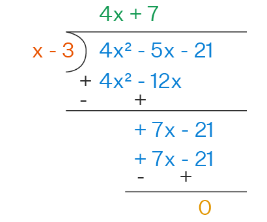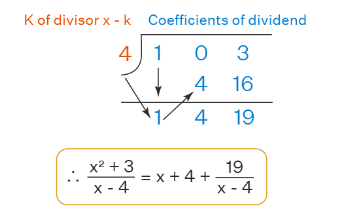How to Divide Polynomials?
Dividing polynomials is an arithmetic operation in which a polynomial is divided by another polynomial. In this article, let's familiarize ourselves with dividing polynomials.

Dividing polynomials is an operation in which a polynomial is divided by another polynomial, usually to a lesser degree as compared to the dividend. Dividing two polynomials may or may not lead to polynomials.
Related Topics
A step-by-step guide to dividing polynomials
Polynomials are algebraic expressions made up of variables and coefficients. The phrase with the highest degree is placed first, followed by the lower terms.
Polynomial division is an algorithm for solving a rational number that represents a polynomial divided by a monomial or another polynomial. The divisor and the dividend are the same as we do for regular division.
Dividing polynomials by monomials
When dividing polynomials by monomials, the division can be done in two ways:
Splitting the terms method:
Split the terms of the polynomial separated by the operator \(+\) or \(-\) between them and simplify each sentence.
Factorization method:
When dividing polynomials, you may have to factor in polynomials to find a common factor between the numerator and the denominator.
Dividing polynomials using long division
Let’s review the algorithm for dividing polynomials by binomials using an example:

- Divide the first term of the dividend \((4x^2)\) by the first term of the divisor \((x)\) and place it as the first term in the quotient \((4x)\).
- Multiply the divisor by that answer, and place the product \((4x^2- 12x)\) below the dividend.
- Subtract to create a new polynomial \((7x-21)\).
- Repeat the same process with the new polynomial after subtraction.
So, when divide a polynomial \((4x^2 – 5x – 21)\) with a binomial \((x – 3)\), the quotient is \(4x+7\) and the remainder is \(0\).
Dividing polynomials using synthetic division
Synthetic division is a technique for dividing a polynomial by a linear binomial by considering only the values of the coefficients. In this method, we first write polynomials in standard form, including the highest degree to the lowest degree.
When writing with descending powers, use \(0\) as the coefficient of the missing phrases. For example, \(x^3+3\) has to be written as \(x^3+ 0x^2+ 0x + 3\).
Follow these steps to divide a polynomial using the synthetic division method:
Let us divide \(x^2+ 3\) by \(x – 4\).
- Write the divisor in the form of \(x – k\) and write \(k\) on the left side of the division. Here, the divisor is \(x-4\), so the value of \(k\) is \(4\).
- Adjust the division by writing the dividend coefficients on the right and \(k \) on the left.
- Now, bring down the coefficient of the highest degree term of the dividend as it is. Here, the leading coefficient is \(1\) (coefficient of \(x^2)\).
- Multiply \(k\) by that leading coefficient and write the product below the second coefficient to the left side of the dividend. So, we get, \(4×1=4\) that we will write below \(0\).
- Add the numbers written in the second column. So, we get, \(0+4=4\).
- Repeat the same multiplication process \(k\) with the number obtained in step five and write the product in the next column to the right.
- Finally, we write the final answer, which will be one degree less than the dividend. So, in our dividends, the highest degree is \(x^2\), so in the quotient, the highest degree term will be \(x\). Therefore, the answer is obtained \(x+4+\frac{19}{x-4}\).

Exercises for Dividing Polynomials
Divide.
- \(\color{blue}{\left(2x^2-5x-3\right)\div \left(x-3\right)}\)
- \(\color{blue}{\left(2x^{^6}−5x^{^5}−4x^{^4}+10x^{^3}+6x^{^2}−17x+5\right)\div \left(2x−5\right)}\)
- \(\color{blue}{\:8x^6+4x^5−14x^4−5x^3+x^2−2x\div 2x+1}\)
- \(\color{blue}{\frac{27m^6+9m^4−81m^2}{9m^2}}\)

- \(\color{blue}{2x+1}\)
- \(\color{blue}{x^5-2x^3+3x-1}\)
- \(\color{blue}{4x^5-7x^3+x^2-1+\frac{1}{2x+1}}\)
- \(\color{blue}{3m^4+m^2-9}\)
Related to This Article
More math articles
- How to Use Area Models and the Distributive Property to Multiply?
- Half-Angle Identities
- How to Find Asymptotes: Vertical, Horizontal and Oblique
- FTCE Math FREE Sample Practice Questions
- Top 10 SHSAT Math Practice Questions
- How to Use Area Models to Divide Three-digit Numbers By One-digit Numbers
- Journey on the Number Line: How to Multiply Unit Fractions with Whole Numbers
- Areas Formed by Function Contours
- How to Show the Relation in the Coordinate Plane
- 4th Grade SC Ready Math Worksheets: FREE & Printable


















What people say about "How to Divide Polynomials? - Effortless Math: We Help Students Learn to LOVE Mathematics"?
No one replied yet.